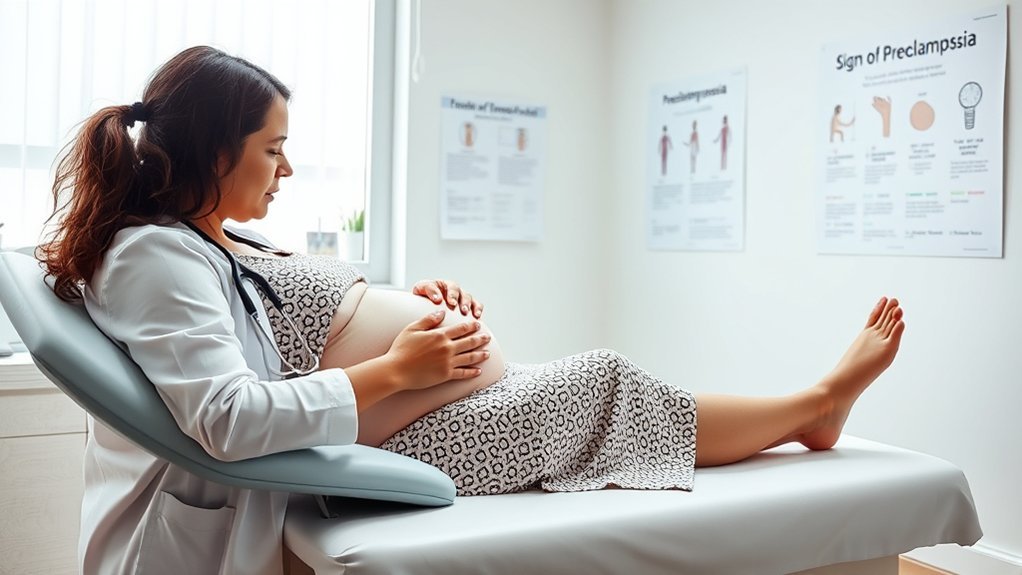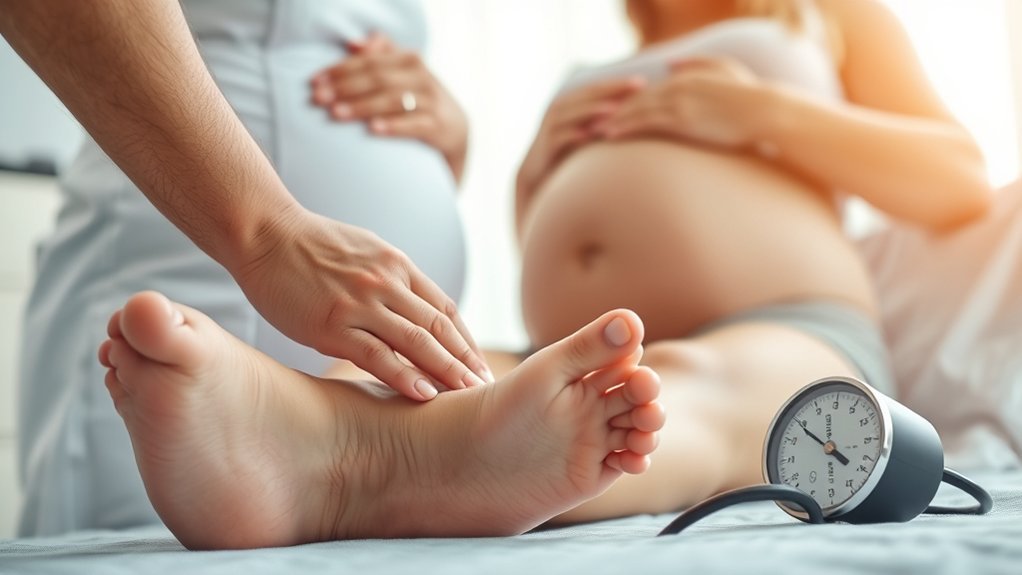Preeclampsia can feel like a storm brewing on the horizon of your pregnancy, often appearing suddenly after the 20th week. Understanding its signs is vital for your health and your baby’s well-being. You might wonder how to distinguish between normal pregnancy changes and those that signal a potential risk. By exploring these common concerns, you can empower yourself to recognize when it’s time to seek medical advice.
What Is Preeclampsia and How Does It Develop?

Preeclampsia is a serious pregnancy-related condition that typically arises after the 20th week, characterized by high blood pressure and signs of damage to other organ systems, often the kidneys.
It develops when the placenta doesn’t function properly, leading to reduced blood flow and oxygen to your body and your baby. Factors like genetic predisposition, obesity, and pre-existing health conditions can increase your risk.
If you’re experiencing any complications, your healthcare provider will monitor you closely. Early detection is essential, as untreated preeclampsia can progress to severe health issues for both you and your baby.
Understanding this condition can help you recognize potential risks and seek timely medical support, ensuring a safer pregnancy journey.
What Are the Common Signs and Symptoms of Preeclampsia?

Recognizing the signs and symptoms of preeclampsia is essential for ensuring the health of both you and your baby.
Common symptoms include high blood pressure, typically over 140/90 mmHg, and protein in your urine. You might notice swelling in your hands and face, and sudden weight gain—more than 2 pounds in a week—could be a red flag.
Headaches that don’t go away with usual remedies or vision changes, such as blurred or distorted sight, are also concerning. Some women experience upper abdominal pain or shortness of breath.
If you notice any of these symptoms, it’s vital to contact your healthcare provider immediately. Early detection and management can help prevent complications for you and your baby.
How Can I Differentiate Between Preeclampsia and Normal Pregnancy Symptoms?

Understanding the differences between preeclampsia and normal pregnancy symptoms is vital for your health and peace of mind.
You’ll want to pay attention to swelling patterns, monitor blood pressure variations, and distinguish between types of headaches.
These factors can help you identify when to seek medical advice, ensuring both you and your baby remain safe.
Swelling Patterns Explained
As you navigate the changes of pregnancy, it’s important to recognize that swelling can be a common occurrence; however, distinguishing between typical pregnancy-related swelling and that associated with preeclampsia is essential for your health.
Here are some key differences to evaluate:
- Location: Normal swelling often affects your feet and ankles, while preeclampsia may cause swelling in your face and hands.
- Onset: Sudden swelling can be a warning sign of preeclampsia.
- Accompanied Symptoms: Look for headaches or visual disturbances alongside swelling.
- Severity: Preeclampsia swelling is often more pronounced and persistent.
- Timing: Swelling that develops after the 20th week of pregnancy warrants attention.
If you notice any concerning patterns, don’t hesitate to reach out to your healthcare provider.
Blood Pressure Variations
Monitoring your blood pressure during pregnancy is essential, as it provides valuable insights into your health.
In normal pregnancies, blood pressure typically remains stable or shows minimal fluctuations. However, in cases of preeclampsia, you might notice significant increases, often above 140/90 mmHg.
If you experience a sudden spike in blood pressure along with other symptoms like protein in your urine or swelling, it’s important to consult your healthcare provider. They’ll evaluate your situation and determine if further action is necessary.
Understanding these variations can help you differentiate between normal pregnancy changes and potential warning signs, ensuring both your well-being and your baby’s health.
Stay vigilant and proactive in monitoring these critical signs throughout your pregnancy journey.
Headache Types Distinction
While headaches are a common occurrence during pregnancy, distinguishing between normal tension headaches and those associated with preeclampsia is essential for your health.
Here are some key differences to watch for:
- Intensity: Preeclampsia headaches are often more severe.
- Duration: Normal headaches typically resolve quickly, while preeclampsia headaches may linger.
- Accompanying Symptoms: Look for symptoms like vision changes, nausea, or abdominal pain.
- Response to Medication: Normal headaches usually respond well to over-the-counter pain relief; preeclampsia headaches may not.
- Timing: Preeclampsia headaches often occur later in pregnancy, especially after the 20-week mark.
If you experience any concerning headaches, don’t hesitate to consult your healthcare provider for guidance.
Your well-being and that of your baby are paramount.
When Should I Seek Medical Attention for Preeclampsia?
If you experience severe headaches or notice changes in your vision, don’t hesitate to reach out to your healthcare provider.
Sudden swelling in your hands, feet, or face, along with unexpected weight gain, are also signs that warrant immediate medical attention.
Your health and the well-being of your baby are paramount, so trust your instincts and seek help when needed.
Severe Headaches and Vision Changes
Severe headaches and vision changes can be alarming symptoms during pregnancy, especially when they signal potential complications like preeclampsia.
It’s essential to recognize when these symptoms warrant immediate medical attention. Consider seeking help if you experience:
- A persistent headache that doesn’t go away with usual pain relief
- Blurred or double vision
- Sudden sensitivity to light
- Visual disturbances, like seeing spots or flashes
- Any sudden changes in your vision
If you encounter any of these signs, don’t hesitate to contact your healthcare provider.
Early intervention can greatly influence your health and the well-being of your baby. Remember, it’s always better to be cautious and seek guidance when it comes to your pregnancy.
Sudden Swelling and Weight Gain
Sudden swelling and unexpected weight gain can be concerning signs during pregnancy, especially as they may indicate preeclampsia.
If you notice swelling in your hands, face, or feet that occurs rapidly, it’s crucial to take this seriously. While some swelling is typical, a significant change, particularly when combined with a weight gain of more than 5 pounds in a week, warrants immediate attention.
Don’t hesitate to contact your healthcare provider if you experience these symptoms. They can assess your situation and determine the necessary steps to guarantee your health and that of your baby.
What Risk Factors Increase the Likelihood of Developing Preeclampsia?
Several key risk factors can increase the likelihood of developing preeclampsia during pregnancy.
Being aware of these factors is essential for your health and your baby’s well-being. Here are some factors to take into account:
- You’re experiencing your first pregnancy
- You have a family history of preeclampsia
- You’re carrying multiple babies (twins, triplets, etc.)
- You’re over the age of 35
- You have pre-existing health conditions like hypertension or diabetes
Recognizing these risk factors can help you discuss your concerns with your healthcare provider.
Early monitoring and proactive measures can greatly improve outcomes for you and your baby.
Stay informed and engaged during your pregnancy, as knowledge is a powerful tool in managing your health.
How Is Preeclampsia Diagnosed and Treated?
If you have risk factors for preeclampsia, it’s important to know how the condition is diagnosed and treated. Your healthcare provider will monitor your blood pressure and check for protein in your urine during routine visits. If preeclampsia is suspected, further tests may be conducted.
Here’s a quick overview of diagnosis and treatment steps:
| Diagnosis Steps | Treatment Options |
|---|---|
| Blood pressure measurement | Close monitoring |
| Urine tests | Medication (e.g., antihypertensives) |
| Blood tests | Possible early delivery |
| Ultrasound | Bed rest or hospitalization |
| Symptoms assessment | Supportive care |
Early detection and appropriate treatment can greatly improve outcomes for both you and your baby. Always communicate any concerning symptoms to your healthcare team.
Frequently Asked Questions
Can Preeclampsia Occur After Childbirth?
Yes, preeclampsia can occur after childbirth, known as postpartum preeclampsia. It usually develops within days or weeks following delivery. If you experience symptoms, seek medical attention promptly to guarantee your health and safety.
What Is the Long-Term Impact of Preeclampsia?
Preeclampsia can lead to long-term health issues, including high blood pressure, cardiovascular disease, and kidney problems. It is crucial to monitor your health post-pregnancy and discuss any concerns with your healthcare provider for proper management.
Is Preeclampsia Hereditary?
Yes, preeclampsia can have a hereditary component. If you have a family history of the condition, your risk may increase. It’s crucial to discuss your family history with your healthcare provider for tailored guidance.
Can Diet Prevent Preeclampsia?
While diet alone can’t guarantee prevention, nourishing your body with wholesome foods can support overall health. Think of it as planting seeds for a healthier pregnancy, where every choice nurtures both you and your baby’s well-being.
Are There Alternative Therapies for Preeclampsia?
While there aren’t specific alternative therapies proven to treat preeclampsia, some women explore acupuncture or relaxation techniques. Always consult your healthcare provider before trying any alternative methods to guarantee safety and effectiveness for your situation.
Conclusion
In the grand adventure of pregnancy, it’s ironic that something as seemingly mundane as swelling could signal a serious condition like preeclampsia. While you might expect swollen feet to be the main concern, keep an eye on your face and hands instead! Remember, staying informed and vigilant about the signs can make all the difference. So, don’t hesitate to reach out to your healthcare provider—after all, your little one deserves the best start, even if it means a few unexpected twists along the way.
